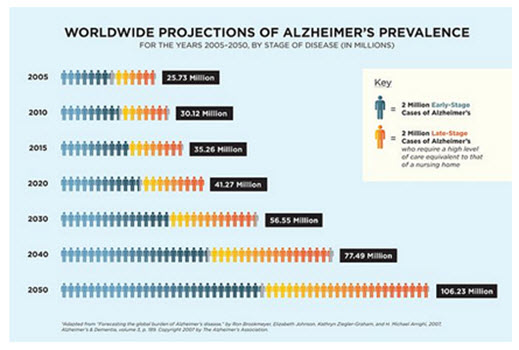In previous blog posts we discussed the relationship between mold and asthma, mold and chronic fatigue syndrome and mold and depression.
This blog post examines the recent research investigating the mold-Alzheimer’s Disease relationship.
For anyone with a family member diagnosed with the disease, you know that Alzheimer’s Disease is a heartbreaking, progressive, degenerative disorder. And you’ve probably watched the progression of memory loss and the disorientation of dementia that accompanies the diagnosis.
From previous research, we know that the brains of people diagnosed with Alzheimer’s Disease have amyloid plaques and tangles among brain cells. The plaques and tangles cause brain cell death, clogged blood vessels, and inflammation. But, while there have been many theories, until recently, no one has been able to identify what causes the damage.
Investigations into the mold-Alzheimer’s Disease relationship started back in 2014 with
“Fungal infection in patients with Alzheimer’s disease.”
In this investigation, the research team examined the brain tissue samples from deceased, elderly people diagnosed with Alzheimer’s disease. Then the team compared the samples with tissue samples from brains of deceased people who did not have Alzheimer’s.
By using DNA sequencing, the research team found several fungal species in the brain samples of deceased Alzheimer’s patients that were not present in the brain tissues of non-Alzheimer controls.
“To our knowledge, these findings represent the first evidence that fungal infection is detectable in brain samples from Alzheimer’s disease patients. The possibility (exists) that this may represent a risk factor or may contribute to the etiological cause of Alzheimer’s disease . . .”
Then, in 2015, the same team published a second research investigation examining the Mold-Alzheimer’s disease relationship. They published
“Direct Visualization of Fungal Infection in Brains from Patients with Alzheimer’s Disease.”
The findings from this research provided an explanation for the “hitherto elusive detection of fungi in brains of people with Alzheimer’s Disease.”
As scary as this idea sounds, even scarier are the researchers’ findings that “fungal cells are actually internalized inside neurons.”
What that means is that mold somehow found its way into the brain cells of people diagnosed with Alzheimer’s Disease.
Then, in September of 2015, the research team published a third report of their findings in “Different Brain Regions are Infected with Fungi in Alzheimer’s Disease.“

So what were the areas of the brain infected with fungi?
“The regions examined were external frontal cortex (EFC), cerebellar hemisphere (CEH), entorhinal cortex/hippocampus (ERH) and choroid plexus (CP).”
And what were the different species of fungi found in the brain tissue of deceased Alzheimer’s patients?
- Candida albicans
- Candida ortholopsis
- Candida tropicalis
- Cladosporium
- Malassezia globosa
- Malassezia restricta
- Neosartorya hiratsukae
- Phoma
- Sacharomyces cerevisae
- Sclerotinia borealis
Cladosporium is one of the most common indoor and outdoor molds.
But at this point you might be wondering
So who cares? And why does this matter?
Simply because we’re living longer!

According to the UCLA biostatistics team in “Sounding the alarm on a future epidemic: Alzheimer’s disease“
- The number of U.S. adults 65 and older is expected to reach 71 million by 2030.
- And the aged population is expected to reach 98 million by 2060.
- However this trend raises the specter of a major public health crisis, a sharp rise in the number of people living with Alzheimer’s disease.
Through a systematic review of Alzheimer’s studies, the UCLA team found that the rate of being diagnosed with the disease doubles every five years in older populations.
“The projected increase in Alzheimer’s cases represents a huge public health problem when you think about the costs associated with caring for a person with the disease, along with the emotional burden for family members.”
Yet, what if the impending “Alzheimer’s Epidemic” could be prevented?
- And because we know that 40% of all residential and commercial buildings in the U.S. have had water damage at some point,
- And because we know that water damaged buildings will grow mold if the water damage isn’t clean, dried, and sanitized completely,
- Perhaps there’s an opportunity to stem the tide of a future Alzheimer’s epidemic?
At PuroClean Emergency Recovery Services we’re all about problem solving and prevention!
So here are the main take-aways from our review of this research literature:
- First, if you have a loved one that was recently diagnosed with Alzheimer’s Disease (AD), please have them evaluated and treated for fungal infections by a medical professional.
- In our Philadelphia, PA and Cherry Hill, NJ area, we’re lucky to have 2 of the top doctors who treat mold exposure and illness related to mold.
- Second, if you have water damage in your home or business, get it clean, dry and sanitized fast to prevent mold growth!
- In light of the current research linking mold and Alzheimer’s Disease,
Mold can’t grow without water and an organic source of nutrients. So, whether you find mold in your attic, your basement, your kitchen, or bathroom, moisture from some source is always involved.
- Third, if you notice mold in your home or workplace, don’t just shrug it off!
Call us immediately at 877-750-7876 to get an inspection as soon as possible. The longer you wait, the more likely exposure to mold can cause problems for you and your loved ones.
